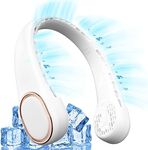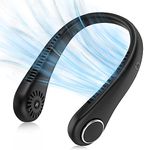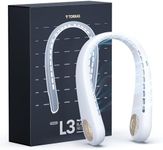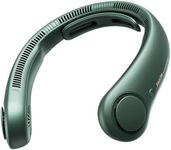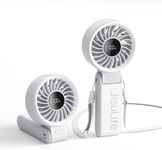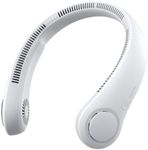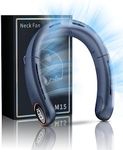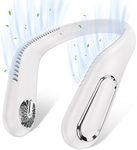Buying Guide for the Best Portable Neck Fan
Choosing a portable neck fan is all about finding the right balance between comfort, cooling power, and convenience. Since these fans are worn around your neck, it's important to consider how they feel during use, how effectively they cool you down, and how easy they are to carry and operate. Think about where and when you'll use the fan most—whether it's for outdoor walks, commuting, exercising, or just relaxing at home. By understanding the key features, you can select a neck fan that fits your lifestyle and keeps you comfortable wherever you go.Battery LifeBattery life refers to how long the neck fan can run on a single charge. This is important because it determines how long you can use the fan before needing to recharge it. Battery life can range from a couple of hours to over ten hours, depending on the fan's speed settings and battery size. Shorter battery life (2-4 hours) might be enough for quick outings or short commutes, while longer battery life (6-10+ hours) is better for all-day use, travel, or outdoor activities. Think about how long you'll typically need the fan running and choose a model that matches your daily routine.
Fan Speed SettingsFan speed settings control how much air the neck fan blows. Most fans offer at least two or three speed options, such as low, medium, and high. Lower speeds are quieter and use less battery, while higher speeds provide stronger cooling but may drain the battery faster and be noisier. If you want flexibility for different situations—like gentle airflow indoors and stronger cooling outdoors—look for a fan with multiple speed settings. Consider your sensitivity to noise and how much cooling you usually need to help decide which range of speeds is best for you.
Weight and ComfortWeight and comfort are about how the fan feels when worn around your neck. A lighter fan is easier to wear for long periods and less likely to cause discomfort or strain. Heavier fans might offer more power or features but can become uncomfortable, especially during extended use. Some fans have soft padding or ergonomic designs to improve comfort. If you plan to wear the fan for hours at a time, prioritize lightweight and well-designed models. Try to imagine how the fan will feel during your typical activities to guide your choice.
Noise LevelNoise level describes how loud the fan is when operating. Quieter fans are less distracting and more pleasant to use in quiet environments like offices or libraries. Louder fans might be acceptable outdoors or in noisy places but could be bothersome in calm settings. Noise levels can vary depending on the fan's speed and design. If you value peace and quiet, look for fans that are specifically described as low-noise or whisper-quiet, especially if you plan to use them in shared or quiet spaces.
Airflow Direction and CoverageAirflow direction and coverage refer to how the fan distributes air around your neck and face. Some fans have adjustable vents or flexible arms that let you direct the airflow where you need it most, while others have fixed vents that provide a general breeze. Wider coverage can cool both sides of your neck and face, while more focused airflow might be better for targeted cooling. Think about whether you want a gentle all-around breeze or more direct cooling, and choose a fan with the airflow design that matches your preference.
Charging MethodCharging method is about how you recharge the fan's battery. Most modern neck fans use USB charging, which is convenient and compatible with many chargers and power banks. Some may use older charging ports or require specific cables. If you want the easiest experience, look for fans with standard USB-C or micro-USB charging. Consider how and where you'll recharge the fan—if you travel often, universal charging options are especially helpful.
Safety FeaturesSafety features include things like bladeless designs, protective grills, and overheat protection. Bladeless fans are safer, especially if you have long hair or will be using the fan around children. Protective grills prevent accidental contact with moving parts. Overheat protection ensures the fan shuts off if it gets too hot. If safety is a concern for you, especially in active or family settings, prioritize fans with these features.
